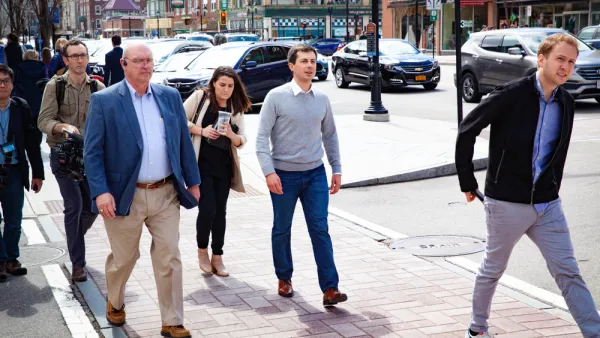Pritzker Prize winner Thom Mayne and leading New Urbanist planner Elizabeth Plater-Zyberk squared off in a debate about the future of Baltimore.

Jared Green reports from a debate that pitted contemporary architect Thom Mayne and New Urbanist planner Elizabeth Plater-Zyberk about the future of Baltimore. According to Green, "[t]heir visions for Baltimore contrast, but the answer to its many economic and social woes may be a little bit of both."
Green summarizes Plater-Zyberk's vision as preserving Baltimore's history at all costs. Plater-Zyberk listed the city's waterfront location, its highly connected street grid, and its historic stock of beautiful buildings as unique assets that could leverage the city revitalization.
Mayne's vision, however, would integrate Baltimore into the global economy. Fans of neighborhoods, new uerbanist or not, might be surprised to hear the crux of Mayne's argument. In his own words: "the precinct, district, township, or neighborhood — the idea of this — is dead. Kids no longer play stick ball in the streets." According to Mayne, there is no on eversion of beauty, as an adherence to the architectural styles of the past might suggest, so Baltimore and other cities like it must pursue a "radical heterogeneity or pluralism."
Green offers his own assessment of the debate, noting a problem "with leading design-thinkers helicoptering in for the day to lay out a city’s future." Green looks around and also sees a lot of efforts already underway to revitalize and redefine Baltimore.
FULL STORY: Which Way to a Better Future for Baltimore?

National Parks Layoffs Will Cause Communities to Lose Billions
Thousands of essential park workers were laid off this week, just before the busy spring break season.

Retro-silient?: America’s First “Eco-burb,” The Woodlands Turns 50
A master-planned community north of Houston offers lessons on green infrastructure and resilient design, but falls short of its founder’s lofty affordability and walkability goals.

Delivering for America Plan Will Downgrade Mail Service in at Least 49.5 Percent of Zip Codes
Republican and Democrat lawmakers criticize the plan for its disproportionate negative impact on rural communities.

Test News Post 1
This is a summary

Test News Headline 46
Test for the image on the front page.

Balancing Bombs and Butterflies: How the National Guard Protects a Rare Species
The National Guard at Fort Indiantown Gap uses GIS technology and land management strategies to balance military training with conservation efforts, ensuring the survival of the rare eastern regal fritillary butterfly.
Urban Design for Planners 1: Software Tools
This six-course series explores essential urban design concepts using open source software and equips planners with the tools they need to participate fully in the urban design process.
Planning for Universal Design
Learn the tools for implementing Universal Design in planning regulations.
EMC Planning Group, Inc.
Planetizen
Planetizen
Mpact (formerly Rail~Volution)
Great Falls Development Authority, Inc.
HUDs Office of Policy Development and Research
NYU Wagner Graduate School of Public Service





























